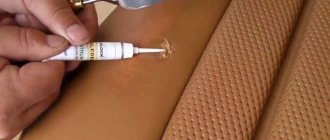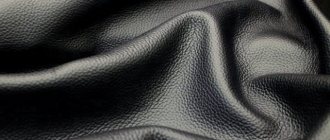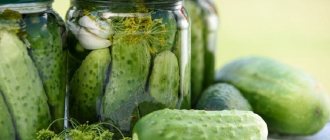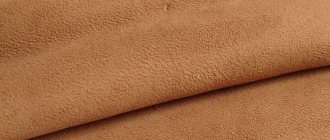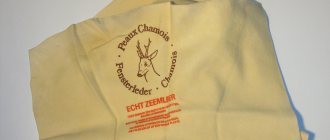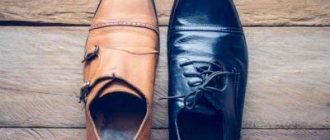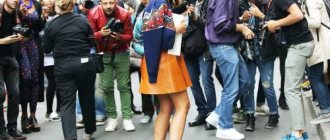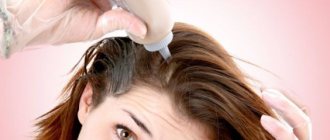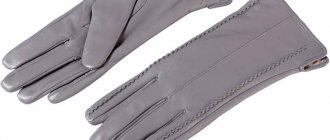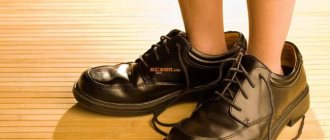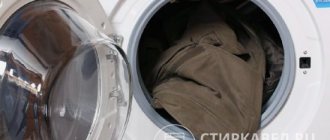The result is a fairly cheap material with low air and moisture permeability, but its production is waste-free. 100% of this very harmful production (phenol-formaldehyde gases that are hazardous to health are released during heating) is concentrated in China. Almost all Chinese leather items are made from pressed leather. This may be acceptable for bags, wallets or belts, but shoes made from such leather (and not necessarily sewn in China) are very harmful - your feet will sweat and get tired, and even kidney disease and skin diseases of the legs are possible. Such shoes will not last long and will quickly lose their shape.
There is probably no need to explain for a long time why pressed leather is needed - to reduce the cost of the leather manufacturing process and reduce the cost of the leather products themselves. To obtain natural leather from animal skin, about fifty production operations are required, and the production of pressed leather, with the appropriate equipment and materials, is much more economical and faster. Pressed leather has the same properties as synthetic leather and consists of a fabric base with a face layer that imitates the surface of natural leather. Pressed leather has a number of disadvantages: it is airtight, brittle and not resistant to wear. In terms of hygiene, this material also cannot compete with natural leather. Clothes made from pressed leather, although cheaper, will not last long, and in severe frost, pressed leather becomes covered with wrinkles and cracks. In this situation, you have to make a choice: buy an expensive leather item once or buy another cheap jacket every season?
When choosing leather clothing, consumers can be misled by the fact that pressed leather is practically no different from natural leather and even smells the same. The most common advice that experts give is not to buy Chinese shoes on the market, since in the vast majority of cases they are made of pressed leather. If you carefully examine leather clothing when purchasing, you can find a fabric base or the presence of threads, which indicate that this leather product is made of pressed leather. Honest manufacturers mark this leather clothing with a “diamond”, but in our conditions they usually prefer to make a branded label, attach it to pressed leather clothing and sell it at exorbitant prices. Not only clothes and shoes are made from pressed leather, but also furniture, bags and various souvenirs imitating genuine leather.
Pressed leather composition and characteristics
It is made from waste from the leather industry. Fibers, scraps, shreds, shavings - everything that remains after cutting and processing natural products is used to make pressed products. Polyester and other chemical components are added for binding.
Appearance
Pressed leather looks almost like natural leather: it has a pronounced relief and a porous texture. It breathes poorly, that is, it does not allow air to pass through, and does not retain water.
Material thickness
It depends on the purpose for which it was created. For the manufacture of car seat covers, shoes, jackets and other items that experience serious mechanical stress, the thickness of the layer is increased to 4 mm. For more sophisticated items, artificial leather from 1 mm is suitable.
Softness
Press leather is pleasant to the touch, elastic, even if it is thick. The material can be bent and folded, but cannot be stretched.
Smell
Recycled leather does not have the specific aroma inherent in natural leather. If low-quality components were used during the production process, the material will have a slight chemical smell.
What to look for when buying leather products?
An inexperienced buyer pays attention only to the appearance of the product, he likes it - and that’s it. But it happens that technological errors in leather processing also occur. It was poorly tanned, poorly pressed, and poorly applied primer. This product will not last long.
A discerning buyer will definitely pay attention to what the reverse side looks like - bakhtarma. From it you can immediately judge the level of leather treatment: it should be smooth, even, well and evenly dyed. And only then he looks at the face - is it natural or skillfully polished.
Be careful when choosing a leather product and it will please you for a long time.
Differences from natural
- Smell. The pressed product does not have a specific aroma, which any natural leather, including boiled leather, has.
- Temperature of the material. If you squeeze the compact in your hands, it will not warm up. Natural skin will become warm and will maintain its temperature for several minutes.
- The wrong side. Pressed leather has a smooth back side, while natural leather looks like suede.
- Water resistance. Natural material absorbs water, from which it becomes covered with dark spots. It does not pass through stamped leather.
- Appearance of the cut. Stamped leather has threads or fabric visible on it.
- Seam quality. They are sealed in press leather and have a flat, straight edge. The natural product has large seams, folded on both sides.
- Reaction to fire. When set on fire, genuine leather smolders, emitting a specific odor, while pressed leather completely burns and turns to ash.
- Label icon. The diamond represents pressed leather, and the stretched leather represents a natural product.
How to distinguish a genuine leather jacket
Budget models of leather outerwear are made from pigskin. However, such material loses its shape in a short time, abrasions and roughness form on the surface, so such a product will not last long. Cowhide leather will become stronger, more reliable and durable due to the greater thickness and rigidity of the raw material. Water does not leak through such material. It does not wrinkle or wear out.
To distinguish genuine leather from eco-leather, run your palm over the surface of the jacket. Genuine material will quickly heat up by hand. And if you apply a few drops of plain water, the moisture will be absorbed and the area will darken slightly. In the opposite cases, you are dealing with leatherette.
Gently run your fingernail over the surface of the jacket. There will be no marks or scratches on the natural material. Inside the original, the edge of the products should be rough, not smooth. To check the quality of the paint, take a white handkerchief or other light-colored cloth and wipe the leather surface. High-quality painting leaves no marks.
Be sure to check the quality of seams, cut and fittings. The edges of the jacket or coat should be neatly hemmed and the seams should be straight. Do not choose products with protruding threads, poor-quality snaps, buttons or zippers. They should be easy to open and close, securely and firmly sewn.
Pay attention to the type of lining of the outerwear. For warm spring and autumn, viscose or polyester is suitable. Choose a demi-season and winter jacket or coat with natural fur. How to care for a leather jacket so that it retains its physical properties and presentable appearance longer, see here.
Description and production
what does pressed leather look like?
What artificial leather is made from: pieces, dust, trimmings - any remnants of natural material.
In addition to primary raw materials, secondary ones are used. That is, the remains of the skin from the press are also used.
How to make pressed leather:
- The remains of natural materials are crushed using a special device. The composition is removed from excess impurities and debris. Remove all components not related to the skin. They are connected to each other under strong pressure from a leather press. To make the connection happen, polyester, polyamide, and polyethylene fibers are added. The resulting piece of flat material is dried in a special oven.
- At high temperatures, synthetics melt and bind together natural tanning waste. In addition to fibers, polyester resins are added. They promote reliable adhesion of skin particles. Synthetic substances impregnate the fabric for better adhesion. It is cooled and the resulting leather is pressed, ready for finishing. The fabric is dyed and designs are applied. They change the texture, structure, relief. Add embossing.
Synthetic leather cannot withstand cold or extreme heat. In the summer, under the sun, at high temperatures, it will begin to melt and lose its shape. In winter, such products crack and become covered with wrinkles. The thing will burst at the bend in two or three months. The canvas does not hold its original shape for long. It does not allow air or moisture to pass through; a person will quickly sweat in such clothes and shoes.
The material also has advantages:
- inexpensive; externally similar to natural, indistinguishable at first glance; Suitable for making many items; beautiful designer things are created from it.
When choosing the right product, recycled matter will bring only positive emotions.
How is artificial leather made?
The basis is taken from natural materials : scraps, substandard residues, leather dust and shavings. Everything is crushed, the mixture is cleared of debris and impurities. Synthetic materials are added to bind the components into a homogeneous mass. Typically these are polyethylene, polyamides and polyesters. The mixture is pressed under high pressure until it forms a solid piece and then dried in an oven. After cooling, a leather-like fabric . It is painted, variously embossed or varnished. The result is a material that occupies an intermediate position between natural and artificial leather.
- What is composite leather: the process of creating the material, comparison with classic genuine leather
Difference from this material
How to distinguish pressed leather from genuine leather:
- The smell is similar to natural. The chemical odor is present even if thoroughly ventilated. To do this, you need to bring the thing close to your nose. If you press a piece of material between your fingers, the pressed material will not change the temperature. The natural material will heat up in a couple of minutes and maintain the temperature for some time. Bend (shoes) or press firmly with fingers (other products). Genuine leather will not leave wrinkles, folds, or creases. The color will also remain unchanged, but you won’t be able to check this on a black item.
- Natural fabric is considered softer and more elastic. Artificial is not elastic, it cracks and breaks a lot. Pressed leather has a smooth underside. But some manufacturers glue artificial suede there to pass it off as natural fabric. The structure and color of natural material cannot be uniform. The pores are located in one direction. They are similar, but don't look 100% the same.
- Primary matter absorbs water and leaves a dark spot on the outside. Recycled materials will not do this. On a natural product, the cuts are not visible; on an artificial one, threads and fabric lining will stick out. Sealed seams, flat straight edges - this is press leather. The edge of the real thing is slightly bent, rolled up and large.
- The set leather gradually smolders, the pressed fabric will burn and become ash. Names of natural materials in different languages: leather, echtleder, genuine vera pelle, cuir. Depending on the country of origin, there should be a similar mark on the label. The diamond symbol indicates artificial fabric, the stretched skin symbol indicates real fabric.
This inexpensive item is definitely made from pressed linen. It is better to check an expensive item in case of dishonesty of the seller.
Products
The manufacturing method makes the fabric impermeable to moisture and air. Moisture resistance is considered only a plus. Air tightness is a property that is unacceptable for shoes and clothing. At the same time, many inexpensive items made from this material are sold. What is the best thing to buy from this fabric:
- bags, wallets, document bags, cases, covers; belts, interior components, accessories; clothes made from a different fabric, but with inserts from the press.
You should not buy jackets, windbreakers, or boots. After a few months, shoes and outerwear will crack and there will be a network of wrinkles and folds. It will simply break at the bends. A pressed leather bag or other accessories will outlast clothing items.
Other types
Different types of leather are necessary, because natural primary raw materials are not enough for everything. Not all products require such an expensive fabric.
Vinyl leather
This is a fabric with a porous or uniform one-sided PVC coating. How it is made:
- Preparation of the fabric base. The type of fabric will be determined by subsequent properties. Treatment of the base with solutions and polymer melts. The final finishing with the application of a pattern adds texture.
What is good about vinyl leather:
- resistance to abrasion, scratches, mechanical stress; tensile strength; resistance to ultraviolet radiation, moisture; tolerates temperature changes; does not deteriorate in chlorinated and sea water; tolerates treatment with disinfectants, ingress of oils and gasoline.
What is it used for:
- shoes, haberdashery; production of furniture of different price segments; metal door trim; finishing of residential, office and utility premises.
Vinyl leather is the material of the future. At a relatively low cost, it has good characteristics.
Boiled
Rigid, durable material, yet lightweight. Boiled leather is made by vegetable tanning. After this, they are sent into an adhesive solution or hot water. Oil, wax, rosin, and resins are also used.
Then fattening and painting occurs. At the end it is formed, embossed and dried. Previously, this type of leather was used for cases, sheaths, and sheaths. In antiquity and the Middle Ages for shields and armor.
Stamped
Modern saffiano is stamped leather. It is made in a special way from calf and sheep skins. Often used for making bags, briefcases, and cases. The products repel dirt and do not require special care. Resistant to mechanical damage and scratches.
Textured
It is pressed under special plates with temperature effects. This is necessary for alignment and elimination of defects. Textured matter has some kind of relief, pattern, or imitation of reptile skin.
Printed
Natural, but has a uniform pattern. Easily confused with leatherette. Printed leather allows you to apply any patterns, especially if it is a light shade. It is often used to imitate exotic leathers.
